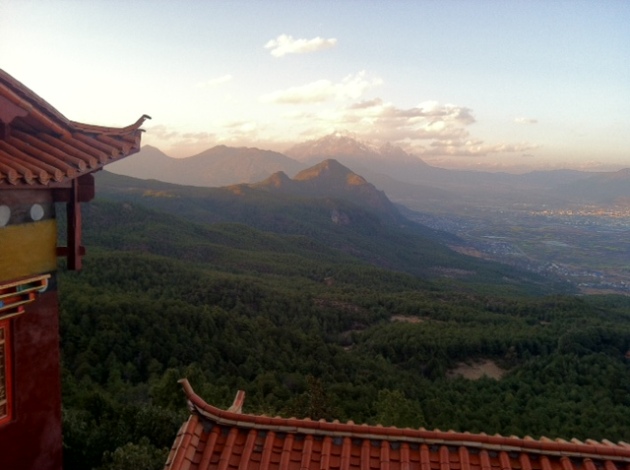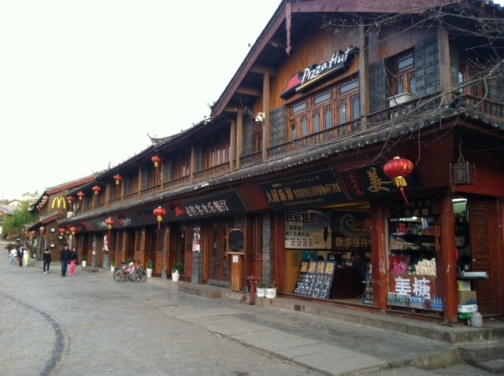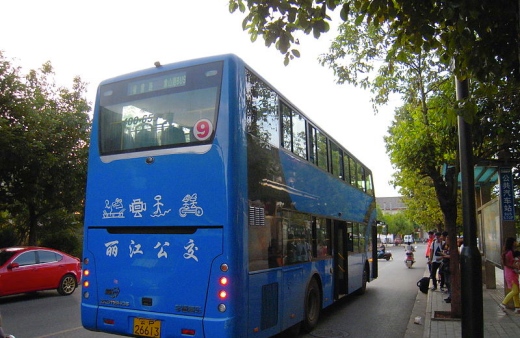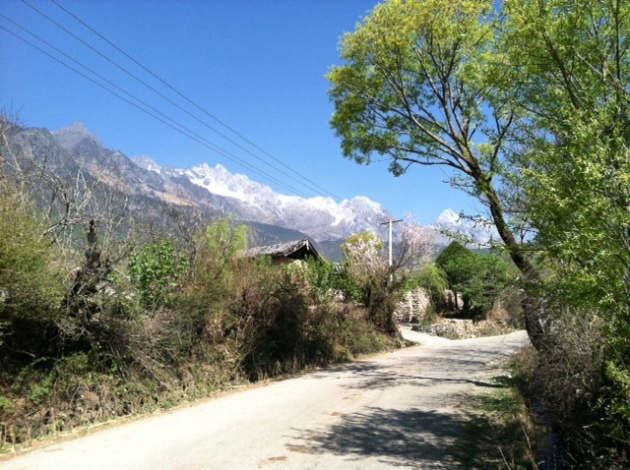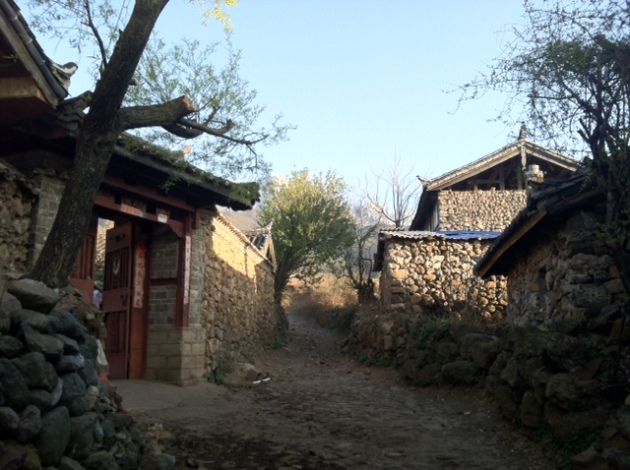Last night, the air quality index (AQI) in Nanjing was close to 600, a level far beyond what is considered “hazardous to human health.” Meanwhile, over 1500 miles away in Lijiang, I spent the evening sitting in a café with a soft breeze blowing the scent of peach blossoms through the open window. The sound of music from a nearby CD store mingled with the stream of water flowing through the street-side canals. Perched up above China’s polluted urban valleys (even Kunming gets bad sometimes), it’s easy to forget that industry and chemicals and hazy purple sunsets are an everyday reality for most of the country. Easy to forget, that is, until a new tour group ambles past the window of the café. The tour groups in Lijiang are easy to spot; massive crowds of pale-skinned middle-aged urbanites, trying fruitlessly to shield themselves from the sun under layers of umbrellas, hats, scarves and sunglasses. For these people, Lijiang has hovered in their imagination for years as the ultimate romantic escape. They saved all year to afford this tour, and when it finishes, they will pile back onto their massive luxury bus and return to their industrial, polluted lives. I’m one of the lucky ones; I get to stay here, at least for a while.
Before I came to Lijiang, I knew very little about it. People had told me that it was beautiful (true), and a massive tourist trap (also sort of true).
The urban area is split into three distinct sections. The new city, where I’m living, looks like an ordinary, small-ish Chinese city. The streets are flat, and the buildings are low and gray. Young mothers with babies on their backs walk past row after row of noodle shops, tiny restaurants, China Mobile retailers, and convenience stores.
The old town (Dayan) is where the tour groups go. It used to be a traditional town occupied by Naxi traders along the Tea-Horse Road. Today, it’s been completely renovated to suit the needs of tourists. The winding, cobble-stoned streets are lined with identical souvenir stalls selling the sorts of things that appeal to hippie travelers: silver jewelry, musical instruments, “ethnic” clothing, and “local” handcrafts. The negative is that it sometimes feels more like an outdoor mall than an historic village. The positive is that the tourists tend to congregate on a few main streets, leaving most of the twisted alleys quiet and fun to explore. There are also lots of cafes suited to Western tastes, which I certainly can’t complain about.

Then there’s the third part. If you take a bus just 30 minutes outside the main city area, you will find yourself in rural farmland. The villages here are real villages: traditional, functional, and often very poor. The people who live in these not-so-remote places come from generations and generations of rural farmers. They may or may not speak Chinese. They may or may not have ever encountered a foreigner before.
Lijiang is extremely ethnically diverse, especially by Chinese standards. Various sources claim that anywhere between 12 and 22 ethnic groups live in the city and surrounding areas. I certainly can’t name them all, but the most prominent groups in the area seem to be Han, Naxi, Hui, Tibetan, Bai, Lisu, Pumi, Yi, and Mosuo. Lijiang is designated as an Autonomous County for the Naxi people (纳西族), whose population numbers around 327,000 (about 0.02% of all China).
Maybe it’s just me, but the first time I saw that word I misread it as “Nazi.” I think I’m probably not alone, because Wikipedia chooses the spelling “Nakhi,” which I have never seen anywhere else. In any case, don’t worry; the Nazis would have hated the Naxis as much as they hated anybody else.
The Nature Conservancy office in Lijiang where I’m volunteering has a relatively large percentage of Naxi people, so I’ve been lucky to have the opportunity to learn a little more about their culture. Here are a few things I’ve learned so far:
1. Naxi culture is alive and well. Coming from a rich cultural, religious, and literary history, most Naxis seem to have a firm sense of ethnic identity. Most older women still wear their traditional clothing (although the younger generation does not), and spend their mornings and evenings dancing traditional dances together in the parks and public squares. Most families speak the Naxi language, which is a Tibeto-Burman language from the Sino-Tibetan family.
2. But the language isn’t necessarily safe. Many young people living in the urban parts of Lijiang are less proficient in the Naxi language than their parents. A 25-year-old girl in my office says that she can understand it, but cannot speak it well. Modern elementary schools hang giant banners in the schoolyard reminding students only to speak Putonghua (standard Mandarin). Although Naxi language is taught as a subject in local schools a few times a week, most people I’ve talked to agree that the instruction is too inconsistent to make a real difference. Minority language preservation is a common debate throughout the world, as young people stop seeing the value in a native language that cannot be used for wider communication. I happen to believe that since language is such a crucial conveyor of cultural knowledge and identity, effort should be made to maintain its use–as long as the speakers themselves are willing. Since the Chinese government is unlikely to embrace a bilingual or otherwise culturally-aware curriculum in schools, I hope that Naxi parents continue to foster a sense of cultural and linguistic identity in their children.
3. They have the only true pictographic writing system in the modern world. Unlike Chinese characters, which combine many types of literal, abstract, and phonetic representation (see this explanation of Chinese characters for more detail), pictographic writing does not indicate pronunciation, and could therefore theoretically be read by speakers of different languages. Naxi writing, called Dongba script (东巴文), consists of characters that look very similar to the ideas they convey. Because of this, linguists usually do not consider it a “complete” representation of the language, since it can be read with multiple interpretations. A syllabic writing system called Geba is sometimes used to annotate Dongba texts.
4. Dongba script was never used as an everyday written language, the way we use the Latin alphabet to write grocery lists and Youtube comments. Instead, the script was kept, studied, and used almost exclusively by the Dongbas, or religious leaders. The script therefore served a primarily ritual purpose. Nowadays street signs, restaurants, and even buses are labeled in Dongba script. I’m not sure whether this is an artificial appropriation for the benefit of tourists, or a legitimate and admirable attempt to modernize the script for everyday use. Whatever the case, very few people truly study the script today.
That’s it for now. I didn’t really mean to make this post all about language and writing, I swear! Hopefully I will continue to learn more about the cultures of the people living in northwest Yunnan. I’ll keep you posted.

